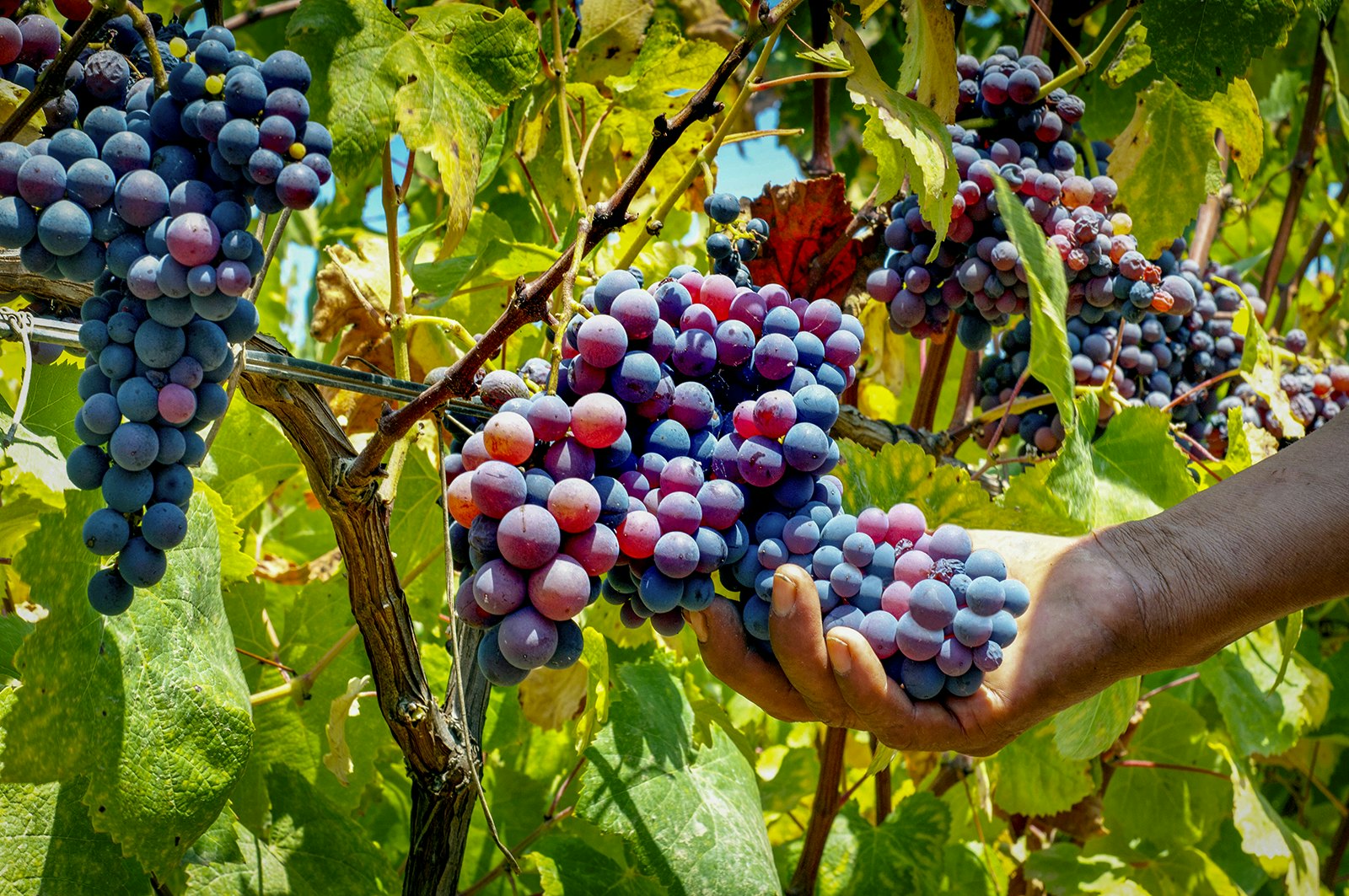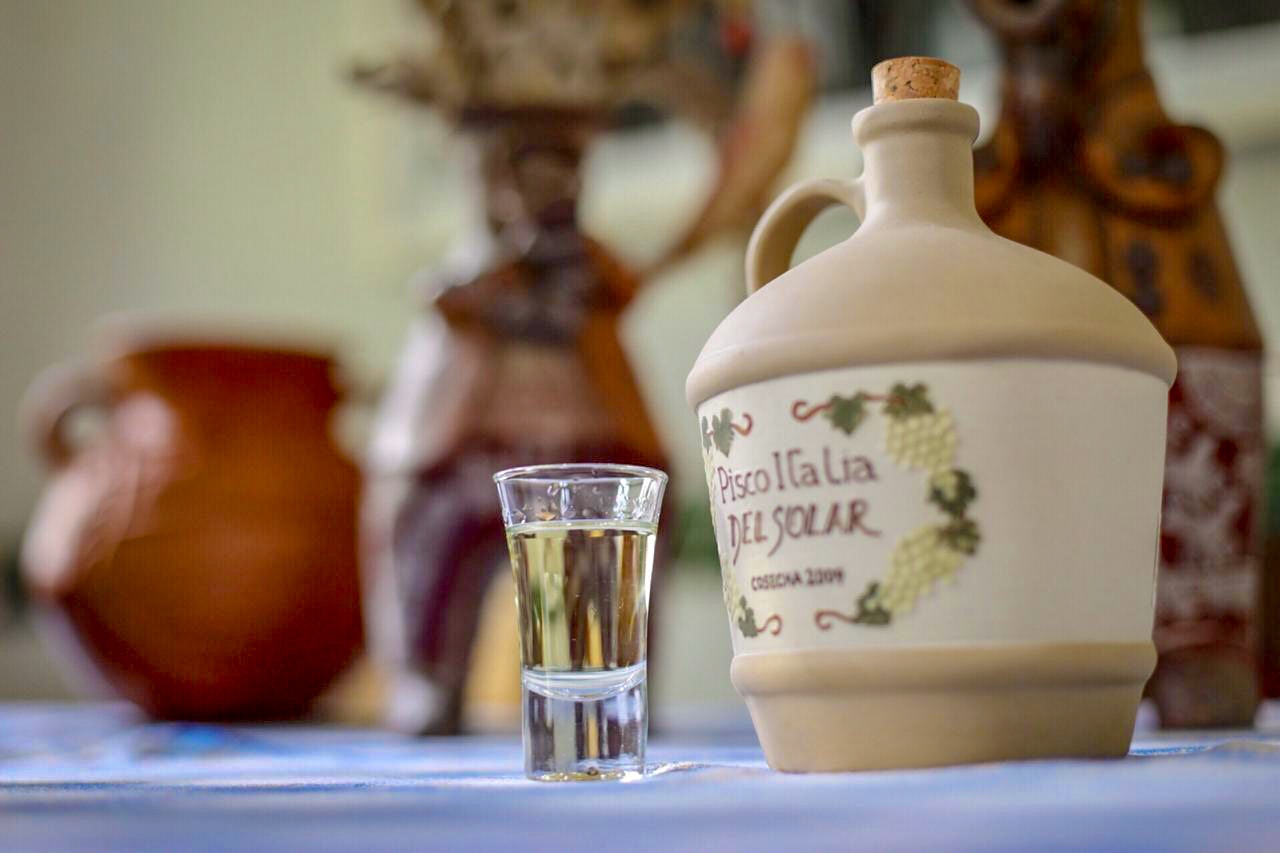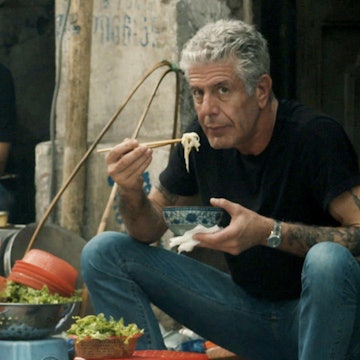

Vines in a winery of Ica used for the production of high quality wines, pisco and champagne, Peru. Colorful fuchsia or magenta bougainvillea flowers in the foreground. © SL_Photography / Getty Images
In the lush valleys of southern Peru, every year between March and April, grapes designated for pisco are harvested, fermented and distilled in order to be enjoyed by June. Peru's signature spirit comes from artisanal and industrial producers alike, but regardless of its origin, it’s a name that first must be earned.

From chicha, to wine, to pisco
During the Inca Empire the drink of choice for rituals and festivities was chicha, a beverage made from corn that was chewed to a pulp then fermented. In the mid-16th century, however, such a beverage just wouldn’t do for Spanish viceroyalty.
Soon after Peru was colonized by the Spanish, the first products to be cultivated were wheat (for bread), olives (for oil — not for cooking, but to light torches with in order to illuminate the city) and the grape. The climbing vines thrived along the southern coast of the Andean country, allowing landowners to produce wine, which was to be enjoyed on its own and used to purify water for drinking.
Substantial amounts of Peruvian wines were exported to Spain where they were so well received that King Philip IV saw them as a threat to national production. As a result, Spain prohibited the importation of Peruvian wines in 1614, a decision that would change everything. Wine producers in Peru, a land with extreme summer heat, suddenly faced the dilemma of what to do with all of their wine before it turned to vinegar. Distillation was the answer, and quickly their focus switched to producing brandy.
The grape liquor would find its way to Peru’s southern port of Pisco, located in what today is known as the department of Ica. Much like what happened with the spirit’s French cousins Cognac and Armagnac, the reputation for the high-quality liquor grew and the name of the port stuck with it. Quite unlike its brandy brethren, however, pisco would prove singular in the world of spirits and even strike up a bit of drama along the way.

The Pisco Belt
In 1991, Peru’s national government recognized the stretch of five valleys – Lima, Ica, Arequipa, Moquegua and Tacna – as pisco’s protected designation of origin. Reaching from Peru’s central coast to the southern tip, any distilled grape beverage produced outside of this area can’t legally call itself pisco.
However, the country’s southern neighbor, Chile, would beg to differ.
Though the Spanish viceroyalty of Peru considered Peru and Chile as one territory in the 16th and 17th centuries, the two neighboring countries would battle it out in the War of the Pacific (1879 - 1883). Chile’s victory gained the southernmost country the Atacama desert and Tacna, though the latter would be returned to Peru in 1929. The brief ownership of Tacna, now part of Peru’s pisco belt, is perhaps why Chile claims to be pisco’s denomination of origin thus sparking yet another feud between the two countries. And while international importers of pisco have had to choose sides, for many historians, linguists and other professionals there’s no discussion regarding the drink’s origin.
'It’s a matter of geography and etymology. The word pisco comes from the Quechua word ‘pishku,’ meaning bird,' points out María Elena del Solar, an anthropologist and owner of artisanal pisco company Pisco del Solar. The word doesn't factor into any indigenous language belonging to Chile, though the Chilean government renamed a small town Pisco Elqui in 1936.

Authorized grapes
The unique climate and terrain in the five pisco producing valleys bring to life the eight varieties of white or grey-fleshed grapes allowed for pisco making. Three types of pisco can be made from these aromatic (Moscatel, Torontel, Italia, Albilla) or non-aromatic (Quebranta, Negra Criolla, Uvina, Mollar) varieties, or even a combination of the two.
Pisco puro consists of one grape varietal (either aromatic or non-aromatic), as does Mosto Verde, however the latter is distilled before the fermentation process has finished, thus requiring more grapes, more work and a higher price tag. Acholado is made from a mix of grape varieties, at whatever proportion the producer sees fit.
An immense number of flavor profiles and aromas result from the possibilities of how to mix and balance the grape varieties; yet, more often than not, the new or uninformed consumer misses the depth and richness of a quality pisco, lost in a shaken storm of trendy cocktails.
Jose ‘Pepe’ Moquillaza, ambassador of pisco for Marca Perú and owner of the elusive Pisco Inquebrantable, wants pisco to be regarded by the common public as a delicacy on its own, not solely as the base of a pisco sour.
'When you sip pisco neat, the flavor wraps itself around you,' Moquillaza says. 'A pisco cocktail can’t do that, it doesn’t stick with you. It can’t reveal the singular flavor of the grape, the producer, its origin - it can only leave you feeling refreshed.'

All natural, always singular
For some 35 years, Maria Elena del Solar has partnered with farmers and master distillers to produce her small-batch pisco, which she sells directly out of her home and in select locations around Lima, including gallery and gift shop Dedalo. The company has remained small and family-owned because del Solar prefers it that way.
'It’s difficult to find an industrial pisco that has the same delicate notes of flavor and aroma that an artisan-made, small-batch pisco has,' states del Solar.
And while her opinion may be biased, again enters another variation within the world of pisco: artisanal and industrial. No matter the size, pisco production has basic rules when it comes to the process. For one, it’s all natural: no additives, preservatives, coloring agents, water or anything beyond the juice of grapes enters the fermentation and distillation stages. Unlike most liquors, pisco goes through just one distillation and the result is to proof (38-48 percent ABV).
'The distillation stage of pisco is quite drawn out, so the distiller uses that time to separate the near toxic first drops called ‘the head,’ and the last portion, called ‘the tail,’ which has barely any alcohol,' details Moquillaza. 'What’s left is el corazón, ‘the heart.’ That’s what eventually reaches the consumer.'
When every drop (useful or not) has fallen, the distillation is complete and it’s time for the pisco to rest for at least three months in stainless steel, copper or in the traditional clay botijas.
'Pisco is easy to make,' claims Moquillaza, clearly a proud ambassador. 'It’s a laborious task, but it doesn’t take a degree to make pisco – it takes dedication. And to make a quality pisco, it takes passion.'
Tips for tasting
You’ll find almost every bar in Lima stocked with a bottle of pisco, but nearly all have the intention of turning it into a frothy pisco sour or a bubbly chilcano. Skip the cocktails and sip on a quality pisco – neat. From handsome settings like San Isidro’s Bar Inglés (set inside the Country Club Lima Hotel) to acclaimed restaurants like Central, a fine pisco served by knowledgeable staff is an investment worth making. And if you’re willing and able to put in some time, head four hours south of Lima towards Ica where you can partake in tastings and distillery tours with bodegas like El Catador or Tacama.
Make sure you're ready for anything with travel insurance from our trusted partners.
https://shop.lonelyplanet.com/products/peru-travel-guide?via=Z2lkOi8vbG9uZWx5LXBsYW5ldC9Xb3JrYXJlYTo6Q2F0YWxvZzo6Q2F0ZWdvcnkvNTllZTQ5YzFmOTJlYTE0MTg2MDU4Nzgy
















